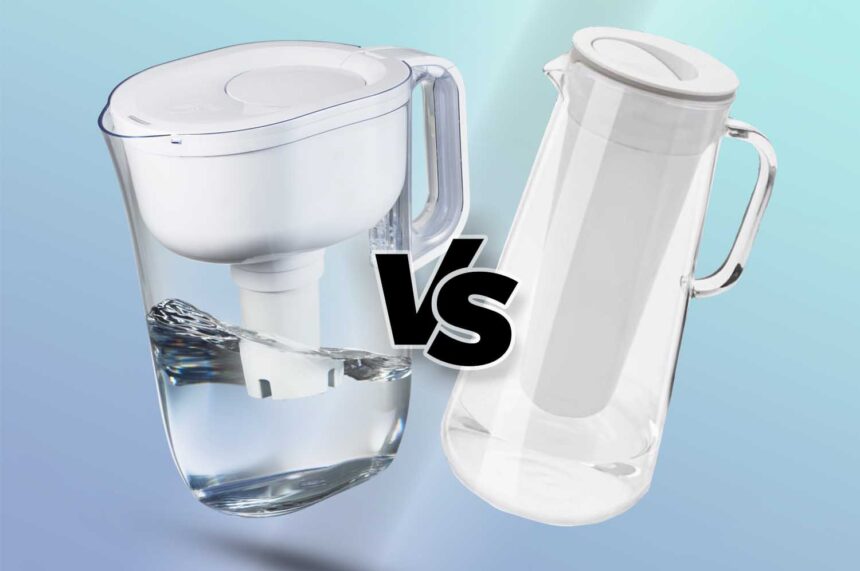Lifestraw and Brita are two popular brands that offer water filter pitchers. These pitchers are designed to remove impurities and contaminants from tap water, providing you with clean drinking water. While both Lifestraw and Brita pitchers serve the same purpose, they have some key differences that set them apart.
Lifestraw pitchers are known for their advanced filtration technology that can remove up to 99.99% of waterborne bacteria and protozoan parasites. They use a two-stage filtration process that includes a hollow fiber membrane and an activated carbon filter. This makes Lifestraw pitchers ideal for use in areas with poor water quality or for outdoor activities like camping and hiking. On the other hand, Brita pitchers use a basic activated carbon filter that can remove chlorine, sediment, and some heavy metals.
When comparing Lifestraw and Brita pitchers, there are several pros and cons to consider. Lifestraw pitchers are more effective at removing contaminants, but they are also more expensive and have a shorter filter lifespan. Brita pitchers are more affordable and have a longer filter lifespan, but they may not be as effective at removing certain contaminants. Ultimately, your choice between Lifestraw and Brita pitchers will depend on your specific needs and preferences.
Key Takeaways
- Lifestraw pitchers use advanced filtration technology to remove up to 99.99% of waterborne bacteria and protozoan parasites, while Brita pitchers use a basic activated carbon filter.
- Lifestraw pitchers are more expensive and have a shorter filter lifespan, but they are more effective at removing contaminants. Brita pitchers are more affordable and have a longer filter lifespan, but they may not be as effective at removing certain contaminants.
- Your choice between Lifestraw and Brita pitchers will depend on your specific needs and preferences.
| Impurity Type | Lifestraw Pitcher | Brita Pitcher |
|---|---|---|
| Chlorine | Yes | Yes |
| Bacteria | Yes | No |
| PFAS (aka: forever chemicals) | Yes | |
| Protozoan Parasites | Yes | No |
| Microplastics | Yes | No |
| Turbidity | Yes | No |
| Lead | Some models | Yes |
| Mercury | Some models | Yes |
| Copper | Some models | Yes |
| Cadmium | Some models | Yes |
| Zinc | No | Yes |
| TDS (Total Dissolved Solids) | No | No |
Overview of Lifestraw Pitcher
If you’re looking for a reliable and efficient water filter pitcher, the Lifestraw Pitcher is an option worth considering. It’s a relatively new product in the market, but it has already gained popularity among consumers due to its unique features and design.
Design and Features
The Lifestraw Pitcher has a sleek and modern design that makes it a great addition to any kitchen. It’s made of durable and BPA-free plastic, ensuring that it’s safe to use for you and your family. The pitcher has a capacity of 7 cups, making it ideal for small households.
One of the unique features of the Lifestraw Pitcher is its advanced filtration technology. It uses a two-stage filtration process that removes up to 99.999% of waterborne bacteria and 99.9% of waterborne protozoan parasites. The first stage consists of a microfiltration membrane that removes all visible particles, while the second stage uses activated carbon to remove any remaining impurities.
The Lifestraw Pitcher also has a long filter life of up to 264 gallons or approximately 6 months, depending on your usage. This means that you won’t have to replace the filter frequently, saving you time and money in the long run.
Performance and Efficiency
When it comes to performance, the Lifestraw Pitcher delivers clean and refreshing water that tastes great. It effectively removes chlorine, bad odors, and other contaminants, leaving you with pure and healthy drinking water.
In terms of efficiency, the Lifestraw Pitcher is easy to use and maintain. It has a convenient fill tray that allows you to fill the pitcher without removing the lid, and the filter replacement indicator lets you know when it’s time to replace the filter.
Compared to other water filter pitchers, the Lifestraw Pitcher is relatively affordable, considering its advanced filtration technology and long filter life. It’s also eco-friendly, as it reduces the need for disposable plastic water bottles.
Overall, the Lifestraw Pitcher is a great choice for anyone looking for a reliable and efficient water filter pitcher. Its advanced filtration technology, long filter life, and sleek design make it a top contender in the market.
Overview of Brita Pitcher
If you’re looking for a reliable and affordable water filter pitcher, the Brita Pitcher is a great option to consider. This pitcher is designed to remove impurities from tap water, providing you with clean and refreshing drinking water.
Design and Features
The Brita Pitcher is a compact and lightweight pitcher that can hold up to 10 cups of water. It is made of BPA-free plastic, which means it is safe to use and won’t leach harmful chemicals into your water.
The pitcher comes with a filter that is designed to reduce the amount of chlorine, mercury, copper, and other impurities in your tap water. The filter is easy to install and replace, and it is recommended that you replace it every 40 gallons or every two months, whichever comes first.
One of the great features of the Brita Pitcher is its flip-top lid, which makes it easy to refill the pitcher without having to remove the entire lid. The pitcher also has a comfort-grip handle, which makes it easy to pour and carry.
Performance and Efficiency
The Brita Pitcher is designed to remove impurities from tap water, making it taste better and safer to drink. According to Brita, their filter can remove up to 99% of lead, chlorine, and other impurities from tap water.
In terms of efficiency, the Brita Pitcher is designed to filter water quickly, so you don’t have to wait long for a fresh glass of water. However, it is worth noting that the filter may not be as effective in areas with high levels of contaminants in the water.
Overall, the Brita Pitcher is a reliable and affordable option for anyone looking to improve the quality of their tap water. Its compact design and easy-to-use features make it a great choice for families, students, and anyone who wants to stay hydrated with clean and refreshing water.
Comparative Analysis
Design Comparison
When it comes to design, both the LifeStraw Pitcher and Brita Pitcher have their own unique features. The LifeStraw Pitcher is a 6.3-inch-wide, 12.6-inch-tall water filter pitcher that can hold up to 7 cups of water. It has a sleek and modern design with a clear plastic body and a blue lid. On the other hand, Brita Pitcher is a bit larger, with a capacity of up to 10 cups of water. It has a more traditional design with a white plastic body and a blue lid.
One of the notable differences between the two pitchers is their filter cartridges. The LifeStraw pitcher uses a replaceable filter cartridge that has a lifespan of 40 gallons or 2 months, whichever comes first. The Brita pitcher, on the other hand, uses a replaceable filter cartridge that has a lifespan of 40 gallons or 2 months, whichever comes first. However, the Brita filter cartridges are more widely available and can be found in most grocery stores.
Performance Comparison
Both the LifeStraw and Brita pitchers are designed to remove impurities from tap water, such as chlorine, lead, and other contaminants. However, the LifeStraw pitcher has an additional filtration layer that is specifically designed to remove PFAS and 1,4-dioxane, which are emerging contaminants that are not removed by traditional filters.
According to a study, both the LifeStraw and Brita pitchers were found to be effective in removing impurities from tap water. However, the LifeStraw pitcher was found to be more effective in removing PFAS and 1,4-dioxane. The study also found that the LifeStraw pitcher had a longer filter life than the Brita pitcher.
In conclusion, both the LifeStraw and Brita pitchers are effective in removing impurities from tap water. However, if you are looking for a pitcher that can remove emerging contaminants such as PFAS and 1,4-dioxane, the LifeStraw pitcher may be the better option. Additionally, if you are looking for a pitcher with a longer filter life, the LifeStraw pitcher may also be the better option.
Pros and Cons
Lifestraw Pitcher
The Lifestraw pitcher is a great option for those who are looking for a water filter that can remove bacteria, protozoa, and other contaminants from the water. It is also designed to be portable, making it ideal for use when camping or traveling.
Pros:
- Removes bacteria and protozoa with >6LRV
- Portable and easy to use
- Long-lasting filter
Cons:
- Does not remove heavy metals or chemicals
- Expensive compared to other pitchers
- Limited capacity (only 7 cups)
Brita Pitcher
The Brita pitcher is one of the most popular water filters on the market. It is designed to remove chlorine, sediment, and other contaminants from the water, making it taste better and safer to drink.
Pros:
- Removes chlorine, sediment, and other contaminants
- Affordable and widely available
- Large capacity (up to 10 cups)
Cons:
- Does not remove bacteria or protozoa
- Requires frequent filter replacements
- Plastic construction may not be as durable as other materials
When it comes to choosing between the Lifestraw pitcher and the Brita pitcher, it ultimately depends on your specific needs and preferences. If you are looking for a portable option that can remove bacteria and protozoa, the Lifestraw pitcher may be the better choice for you. However, if you are looking for a more affordable option that can remove common contaminants, the Brita pitcher may be a better fit.
Conclusion
In conclusion, both the Lifestraw and Brita pitchers have their own unique features and benefits. The Lifestraw pitcher is ideal for those who want a pitcher that can filter out more contaminants and has a longer filter life. It can remove bacteria, protozoa, and other contaminants with >6LRV. It also has a filter life of up to 264 gallons, which is longer than most pitcher filters.
On the other hand, the Brita pitcher is a great option for those who want a pitcher that is affordable and easy to find replacement filters for. It can remove chlorine, zinc, copper, and other contaminants. It has a filter life of up to 40 gallons, which is shorter than the Lifestraw pitcher but still longer than most pitcher filters.
When it comes to design, the Lifestraw pitcher has a sleek and modern design that looks great on any countertop. It also has a convenient pour spout and a lid that flips open for easy filling. The Brita pitcher, on the other hand, has a more traditional design and comes in a variety of colors and sizes to fit your needs.
Overall, both pitchers are great options for anyone looking to improve the quality of their drinking water. Your choice will ultimately depend on your specific needs and preferences. Consider factors such as the contaminants you want to remove, filter life, design, and cost when making your decision.
Frequently Asked Questions
What water filter pitcher removes the most contaminants?
According to Consumer Reports, the water filter pitcher that removes the most contaminants is the ZeroWater pitcher. It removes almost all of the total dissolved solids (TDS) in tap water, which includes minerals, salts, and metals. However, it’s worth noting that removing all TDS can also remove beneficial minerals from the water.
What are the drawbacks of LifeStraw?
One of the main drawbacks of the LifeStraw pitcher is its short filter life. It needs to be replaced after filtering 40 gallons of water or every two months, whichever comes first. This means that it may not be the most cost-effective option for households that consume a lot of water. Additionally, the LifeStraw pitcher doesn’t remove as many contaminants as other pitchers on the market.
Is Brita still the best water filter?
Brita is still a popular choice for many households due to its affordability and availability. However, it’s worth noting that there are other water filter pitchers on the market that remove more contaminants than Brita. In particular, the ZeroWater pitcher and the PUR pitcher both outperform Brita in terms of contaminant removal.
How long does a LifeStraw pitcher last?
The LifeStraw pitcher needs to be replaced after filtering 40 gallons of water or every two months, whichever comes first. This is shorter than the filter life of some other pitchers on the market, so it’s worth considering whether the cost of replacement filters is worth it for your household’s water consumption.
What is the best water filter pitcher according to Consumer Reports?
According to Consumer Reports, the ZeroWater pitcher is the best water filter pitcher on the market. It removes almost all of the total dissolved solids (TDS) in tap water, which includes minerals, salts, and metals. However, it’s worth noting that removing all TDS can also remove beneficial minerals from the water.
Brita vs PUR: Which is better for removing contaminants?
Both Brita and PUR are popular choices for households looking to remove contaminants from their tap water. However, according to Consumer Reports, the PUR pitcher outperforms the Brita pitcher in terms of contaminant removal. Specifically, the PUR pitcher removes more lead and arsenic than the Brita pitcher.







